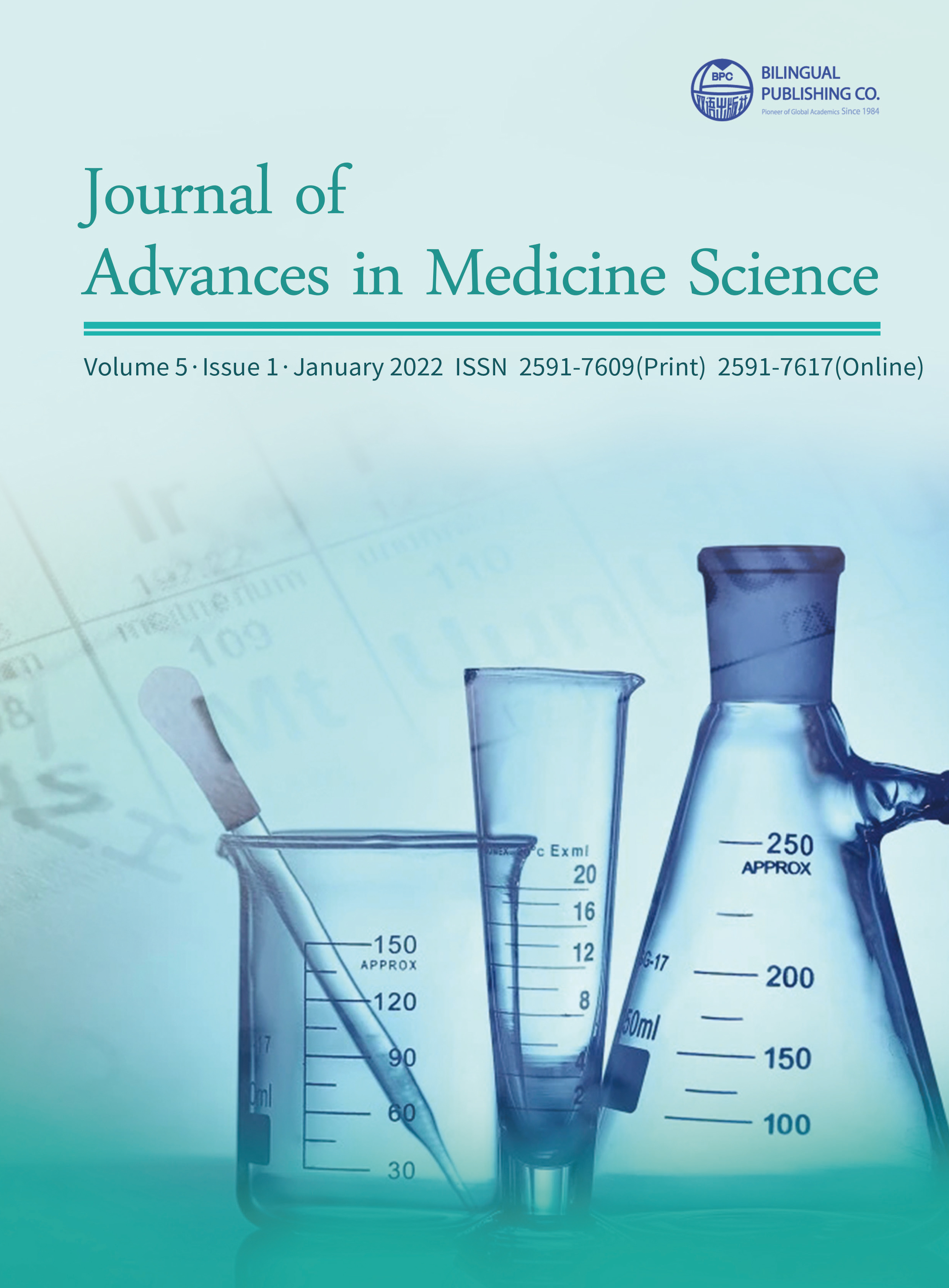Hemichorea Associated with Non-ketotic Hyperglycemia: A Case Report and Review of the Literature
DOI:
https://doi.org/10.30564/jams.v5i1.3691Abstract
Hemichorea associated with non-ketotic hyperglycemia (HC-NH) is a rare disease. The purpose of this case report is to introduce a patient with HC-NH and provide a schedule of examination and follow-up treatment. We also reviewed the current understanding of pathophysiology and treatment and how to apply it to our patients. The case involved a 37-year-old Asian diabetic man who had a 9-day history of losing movement in left limbs and face. His initial blood glucose level was 10.13 mmol/L. HbA1c was 13.6%. Before admission, head CT scan showed suspicious small pieces of left brainstem with slightly high-density shadow and right putamen nucleus with high-density shadow. On the day of admission, head MRI showed punctate T1WI low signal shadow, T2WI high and low mixed signal shadow, T1WI high signal shadow and T2WI low signal shadow of right putamen nucleus. The case findings were consistent with his displayed motor pattern and with the HC-NH diagnosis. Gradual control of the blood glucose levels alleviates his choreiform symptoms. The endocrinology follow-up 6 months after discharge found that his symptoms did not recur after the outpatient’s medication compliance was improved. HC-NH is a rare manifestation of poor diabetes control, but it should also be noticed by clinicians. Early recognition and gradual treatment of elevated blood glucose levels seem to completely alleviate choreiform symptoms.
Keywords:
Chorea, Diabetes mellitus, Nonketotic hyperglycinemiaReferences
[1] Bedwell, S.F., 1960. Some observations on hemiballismus. Neurology. 10, 619-22.
[2] Postuma, R.B., Lang, A.E., 2003. Hemiballism: revisiting a classic disorder. Lancet Neurol. 2(11), 661-668.
[3] Kranick, S.M., Price, R.S., Prasad, S., et al., 2008. Clinical reasoning: a 52-year-old woman with subacute hemichorea. Neurology. 71(20), e59-62.
[4] Oh, S.H., Lee, K.Y., Im, J.H., et al., 2002. Chorea associated with non-ketotic hyperglycemia and hyperintensity basal ganglia lesion on T1-weighted brain MRI study: a meta-analysis of 53 cases including four present cases. J Neurol Sci. 200(1-2), 57-62.
[5] Gomez-Ochoa, S.A., Espin-Chico, B.B., Pinilla-Monsalve, G.D., et al., 2018. Clinical and neuroimaging spectrum of hyperglycemia-associated chorea-ballism: systematic review and exploratory analysis of case reports. Funct Neurol. 33(4), 175-187.
[6] Chang, C.V., Felicio, A.C., Godeiro Cde, O., Jr., et al., 2007. Chorea-ballism as a manifestation of decompensated type 2 diabetes mellitus. Am J Med Sci. 333(3), 175-177.
[7] Bizet, J., Cooper, C.J., Quansah, R., et al., 2014. Chorea, Hyperglycemia, Basal Ganglia Syndrome (C-H-BG) in an uncontrolled diabetic patient with normal glucose levels on presentation. Am J Case Rep. 15, 143-146.
[8] Nakajima, N., Ueda, M., Nagayama, H., et al., 2014. Putaminal changes before the onset of clinical symptoms in diabetic hemichorea-hemiballism. Intern Med. 53(5), 489-491.
[9] Zaitout, Z., 2012. CT and MRI findings in the basal ganglia in non-ketotic hyperglycaemia associated hemichorea and hemi-ballismus (HC-HB). Neuroradiology. 54(10), 1119-1120.
[10] Lin, J.J., Lin, G.Y., Shih, C., et al., 2001. Presentation of striatal hyperintensity on T1-weighted MRI in patients with hemiballism-hemichorea caused by non-ketotic hyperglycemia: report of seven new cases and a review of literature. J Neurol. 248(9), 750-5.
[11] Hsu, J.L., Wang, H.C., Hsu, W.C., 2004. Hyperglycemia-induced unilateral basal ganglion lesions with and without hemichorea. A PET study. J Neurol. 251(12), 1486-1490.
[12] Achilles, E.I., Maus, V., Fink, G.R., et al., 2016. [Hemichorea with Contralateral High Signal Intensity Putaminal Lesion on T1-Weighted Images in Non-Ketotic Hyperglycemia]. Fortschr Neurol Psychiatr. 84(4), 222-225.
[13] Branca, D., Gervasio, O., Le Piane, E., et al., 2005. Chorea induced by non-ketotic hyperglycaemia: a case report. Neurol Sci. 26(4), 275-277.
[14] Cheema, H., Federman, D., Kam, A., 2011. Hemichorea-hemiballismus in non-ketotic hyperglycaemia. J Clin Neurosci. 18(2), 293-294.
[15] Chung, S.J., Im, J.H., Lee, M.C., et al., 2004. Hemichorea after stroke: clinical-radiological correlation. J Neurol. 251(6), 725-729.
[16] Ehrlich, D.J., Walker, R.H., 2017. Functional neuroimaging and chorea: a systematic review. J Clin Mov Disord. 4, 8.
[17] Bhidayasiri, R., Truong, D.D., 2004. Chorea and related disorders. Postgrad Med J. 80(947), 527-534.
[18] Pandey, S., Chorea, J., 2013. Assoc Physicians India. 61(7), 471-4, 483.
Downloads
Issue
Article Type
License
Copyright and Licensing
The authors shall retain the copyright of their work but allow the Publisher to publish, copy, distribute, and convey the work.
Journal of Advances in Medicine Science publishes accepted manuscripts under Creative Commons Attribution-NonCommercial 4.0 International License (CC BY-NC 4.0). Authors who submit their papers for publication by Journal of Advances in Medicine Science agree to have the CC BY-NC 4.0 license applied to their work, and that anyone is allowed to reuse the article or part of it free of charge for non-commercial use. As long as you follow the license terms and original source is properly cited, anyone may copy, redistribute the material in any medium or format, remix, transform, and build upon the material.
License Policy for Reuse of Third-Party Materials
If a manuscript submitted to the journal contains the materials which are held in copyright by a third-party, authors are responsible for obtaining permissions from the copyright holder to reuse or republish any previously published figures, illustrations, charts, tables, photographs, and text excerpts, etc. When submitting a manuscript, official written proof of permission must be provided and clearly stated in the cover letter.
The editorial office of the journal has the right to reject/retract articles that reuse third-party materials without permission.
Journal Policies on Data Sharing
We encourage authors to share articles published in our journal to other data platforms, but only if it is noted that it has been published in this journal.




 Qin Xu
Qin Xu

